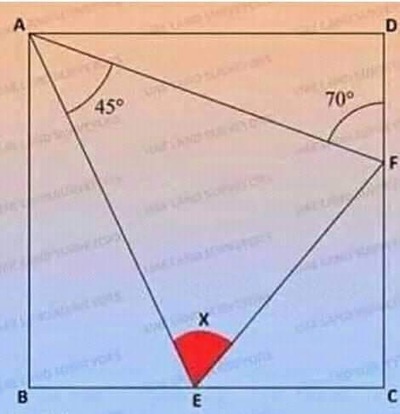This section requires Javascript.
You are seeing this because something didn't load right. We suggest you, (a) try
refreshing the page, (b) enabling javascript if it is disabled on your browser and,
finally, (c)
loading the
non-javascript version of this page
. We're sorry about the hassle.
2 solutions
By angle chasing, we find that ∠ B A E = 2 5 ∘ and ∠ A E B = 6 5 ∘ . Then ∠ F E C = 1 8 0 ∘ − 6 5 ∘ − x ∘ = 1 1 5 ∘ − x ∘ and
tan ( 1 1 5 ∘ − x ∘ ) 1 1 5 ∘ − x ∘ ⟹ x = C E F C = 1 − tan 2 5 ∘ 1 − tan 2 0 ∘ = 1 − tan 2 5 ∘ 1 − tan ( 4 5 ∘ − 2 0 ∘ ) = 1 − tan 2 5 ∘ 1 − 1 + tan 2 5 ∘ 1 − tan 2 5 ∘ = 1 − tan 2 2 5 ∘ 2 tan 2 5 ∘ = tan 5 0 ∘ = 5 0 ∘ = 6 5 Let A B = B C = C D = D A = 1

consider triangle ADF and ABE (sorry to say i still don't know how to answer which look beautiful enough in the way of math) AD=BD cos(20) AF = cos(25) AE
A E A F = c o s ( 2 0 ) c o s ( 2 5 ) for triangle AEF take a perpendicular to EF which go though A. now we have two triangles AOE and AOF
so AO = sin(x) AE and AO = sin(y) AF
A E A F = s i n ( y ) s i n ( x ) = c o s ( 2 0 ) c o s ( 2 5 ) = s i n ( 7 0 ) s i n ( 6 5 )
y x = 7 0 6 5
x= 65k ( k is a constant) for triangle k=1
so x = 65